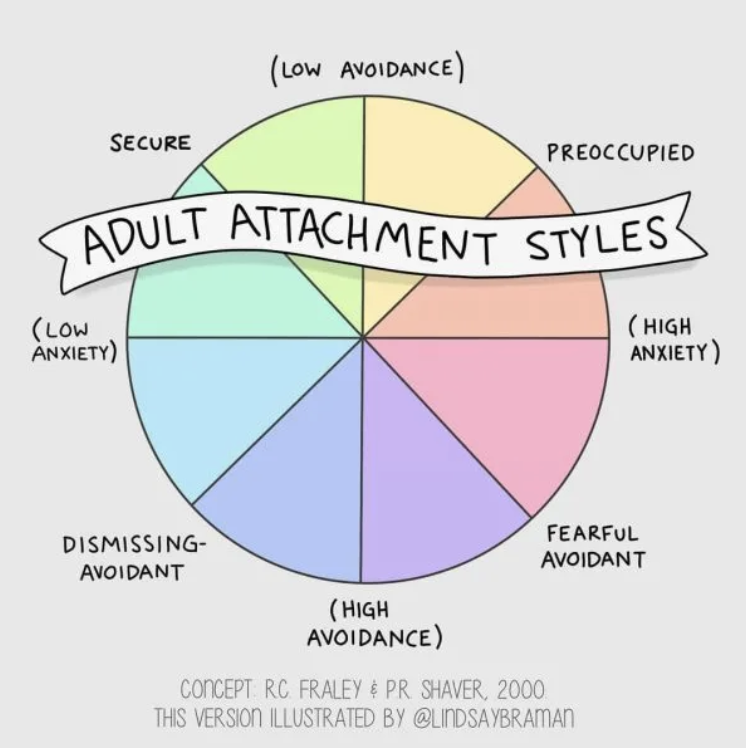Attachment Styles 101
What are attachment styles? Attachment styles refer to how we show up in relationships both with others and ourselves. They describe not only our behavior but also our thoughts and emotions toward our relational others and self. Below, we’ll break down the different ‘types’ of attachment, and offer resources for better understanding the styles and their impacts on your relationships.
An important note I want to make is that attachment styles aren’t fixed and aren’t generalized across all our relationships. Rather than considering one of these as *your* attachment style, I invite you to consider how you show up in which types of relationships. For example, someone may be preoccupied with their work/colleague relationships but more dismissive-avoidantly attached in romantic relationships. This same person may exhibit secure attachment within platonic friendships. The context of the relationship is as important to shaping our attachment as the relationship itself.
Preoccupied Attachment
As the graphic above illustrates, preoccupied attachment is characterized by high anxiety and low avoidance. This means folks who resonate with this style often find themselves in a state of hypervigilance, yearning to feel valued in relationships and unable to self-regulate and contain. They may consistently scan the other person’s behavior and mood for any perceived signs of disgruntlement or disinterest, and often seek proximity and reassurance that they’re valued/important to the other person.
Fearful Avoidant Attachment
Fearful avoidant attachment is characterized by high anxiety and high avoidance. This means they often have a strong desire for relational closeness, just like preoccupied folks, but inherently don’t trust the feeling of closeness. Folks who resonate with this style find themselves deeply yearning for intimacy and connection but avoiding it whenever it may be offered to stave off the ‘inevitable’ sense of rejection. How someone experiences this style will be dependent on if they’re in a relationship or not, as folks with fearful-avoidant as their dominant style tend to avoid close relationships. But once people with this attachment style are in a close relationship, they present as highly anxious and seek reassurance.
Dismissing Avoidant Attachment
Dismissing avoidant attachment is characterized by high avoidance and low anxiety. This means they often de-prioritize their relationships and potential relationships, without much distress. Folks who resonate with this style likely consider themselves self-sufficient, stoic, and may consider other people’s needs as threats to their independence. The relationships they have can feel stifling and they may find themselves deliberately distressing the relationship to avoid increased closeness and proximity.
Secure Attachment
Secure attachment is characterized by low anxiety and low avoidance. This means they can expand toward connection and contract toward autonomy in a regulated way that honors their needs and the needs of the person they’re in relationship with. Their self-worth is intrinsic and not reliant on the quality or quantity of their relationships, although they tend to naturally seek out people that affirm that sense of self-worth.
Disorganized Attachment
As the graphic below illustrates, disorganized attachment is, well… disorganized. Often this attachment ‘style’ manifests as a result of extreme overwhelm and inconsistency in someone’s family of origin. This can look like any of the styles outlined above, and the key difference is that someone with this as their dominant style will likely exhibit all the other styles within a single relationship. Folks with this as their dominant style often can’t predict how they’ll react to the other person’s emotions and behaviors, because growing up, the same reaction often generated vastly different results.
Takeaways:
As I said in the beginning, it’s important to remember that attachment styles aren’t fixed. Anyone with an insecure attachment style can move toward earned secure attachment through the experience of being genuinely seen, loved, and cared for by others via authentic vulnerability and intimacy. Likewise, anyone with a secure attachment style can become insecurely attached if they experience relational overwhelm that outpaces their capacity or resources, such as in the case of an abusive relationship. Therapy is a fantastic model for developing a secure attachment as good therapists will offer the attuned, mindful connection that moves people towards security.
Want to learn more?
Polysecure: Attachment, Trauma, and Consensual Non-Monogamy by Jessica Fern
Despite the name, I think this is a great resource for anyone, including monogamous folks, to better understand how their attachment desires/fears impacts the relationships in their lives + offers a roadmap for strategies on navigating insecure attachment
The Power of Attachment: How to Create Deep and Lasting Intimate Relationships by Diane Poole Heller
Lays out how our experiences in life shape + influence our attachment within ourselves, our relationships, and the world at large + offers practical tools for healing those wounds toward a connected, intimate life


